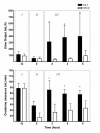Angiotensin II in experimental hyperdynamic sepsis
- PMID: 19948019
- PMCID: PMC2811902
- DOI: 10.1186/cc8185
Angiotensin II in experimental hyperdynamic sepsis
Abstract
Introduction: Angiotensin II (Ang II) is a potential vasopressor treatment for hypotensive hyperdynamic sepsis. However, unlike other vasopressors, its systemic, regional blood flow and renal functional effects in hypotensive hyperdynamic sepsis have not been investigated.
Methods: We performed an experimental randomised placebo-controlled animal study. We induced hyperdynamic sepsis by the intravenous administration of live E. coli in conscious ewes after chronic instrumentation with flow probes around the aorta and the renal, mesenteric, coronary and iliac arteries. We allocated animals to either placebo or angiotensin II infusion titrated to maintain baseline blood pressure.
Results: Hyperdynamic sepsis was associated with increased renal blood flow (from 292 +/- 61 to 397 +/- 74 ml/min), oliguria and a decrease in creatinine clearance (from 88.7 +/- 19.6 to 47.7 +/- 21.0 ml/min, P < 0.0001). Compared to placebo, Ang II infusion restored arterial pressure but reduced renal blood flow (from 359 +/- 81 ml/min to 279 +/- 86 ml/min; P < 0.0001). However, despite the reduction in renal blood flow, Ang II increased urine output approximately 7-fold (364 +/- 272 ml/h vs. 48 +/- 18 ml/h; P < 0.0001), and creatinine clearance by 70% (to 80.6 +/- 20.7 ml/min vs.46.0 +/- 26 ml/min; P < 0.0001). There were no major effects of Ang II on other regional blood flows.
Conclusions: In early experimental hypotensive hyperdynamic sepsis, intravenous angiotensin II infusion decreased renal blood while inducing a marked increase in urine output and normalizing creatinine clearance.
Figures




Similar articles
-
Effects of renal denervation on regional hemodynamics and kidney function in experimental hyperdynamic sepsis.Crit Care Med. 2014 Jun;42(6):e401-9. doi: 10.1097/CCM.0000000000000302. Crit Care Med. 2014. PMID: 24670939
-
Intrarenal blood flow distribution in hyperdynamic septic shock: Effect of norepinephrine.Crit Care Med. 2003 Oct;31(10):2509-13. doi: 10.1097/01.CCM.0000084842.66153.5A. Crit Care Med. 2003. PMID: 14530759
-
The haemodynamic and metabolic effects of epinephrine in experimental hyperdynamic septic shock.Intensive Care Med. 2005 Mar;31(3):454-62. doi: 10.1007/s00134-005-2580-x. Epub 2005 Feb 15. Intensive Care Med. 2005. PMID: 15711973
-
Vital organ blood flow during hyperdynamic sepsis.Chest. 2003 Sep;124(3):1053-9. doi: 10.1378/chest.124.3.1053. Chest. 2003. PMID: 12970037
-
Angiotensin II in Refractory Septic Shock.Shock. 2017 May;47(5):560-566. doi: 10.1097/SHK.0000000000000807. Shock. 2017. PMID: 27879559 Review.
Cited by
-
Dynamic changes in the real-time glomerular filtration rate and kidney injury markers in different acute kidney injury models.J Transl Med. 2024 Sep 27;22(1):857. doi: 10.1186/s12967-024-05667-w. J Transl Med. 2024. PMID: 39334187 Free PMC article.
-
Drugs in Development for Acute Kidney Injury.Drugs. 2019 Jun;79(8):811-821. doi: 10.1007/s40265-019-01119-8. Drugs. 2019. PMID: 31004331 Review.
-
Antihypertensive agents acting on the renin-angiotensin system and the risk of sepsis.Br J Clin Pharmacol. 2014 Nov;78(5):1151-8. doi: 10.1111/bcp.12419. Br J Clin Pharmacol. 2014. PMID: 24803383 Free PMC article.
-
Renal bioenergetics during early gram-negative mammalian sepsis and angiotensin II infusion.Intensive Care Med. 2012 May;38(5):886-93. doi: 10.1007/s00134-012-2487-2. Intensive Care Med. 2012. PMID: 22302028
-
Physiological aspects of Toll-like receptor 4 activation in sepsis-induced acute kidney injury.Acta Physiol (Oxf). 2017 Mar;219(3):573-588. doi: 10.1111/apha.12798. Epub 2016 Oct 8. Acta Physiol (Oxf). 2017. PMID: 27602552 Free PMC article. Review.
References
-
- Uchino S, Kellum JA, Bellomo R, Doig GS, Morimatsu H, Morgera S, Schetz M, Tan I, Bouman C, Macedo E, Gibney N, Tolwani A, Ronco C. beginning and Ending Supportive Therapy for the kidney (BEST kidney) investigators. Acute renal failure in critically ill patients: a multinational, multicenter study. JAMA. 2005;294:813–818. doi: 10.1001/jama.294.7.813. - DOI - PubMed
-
- Bellomo R, Ronco C. Renal replacement therapy in the intensive care unit. Crit Care Resusc. 1999;1:13–24. - PubMed
Publication types
MeSH terms
Substances
LinkOut - more resources
Full Text Sources
Other Literature Sources
Medical
Miscellaneous

